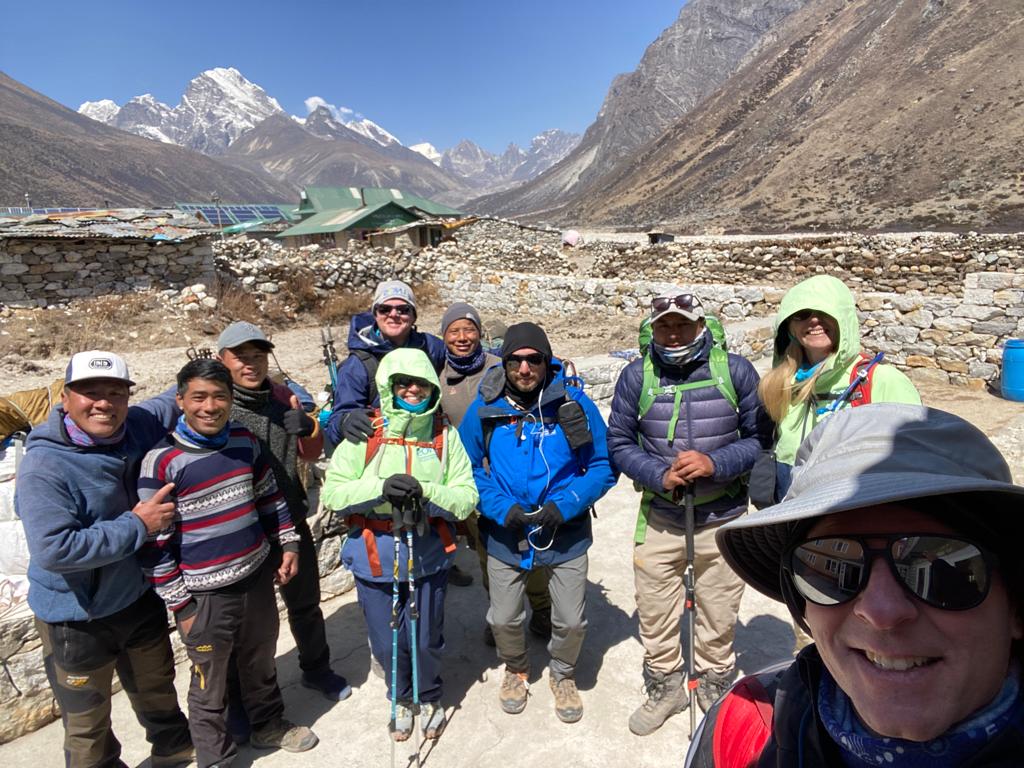To the base of Everest on one kidney
A trek to prove kidney transplant donors can live healthy, active livesWhen a soccer coach from Seattle, a registered nurse from Indianapolis, and a former US Marine from Miami met recently, they had one thing in common. They all had only one kidney, having donated the other one.
In April, Cristina Fontana, Bobby McLaughlin, and Gionnon Goldhagen, two of their partners and a support team undertook the 12-day trek to the 5,364m Everest Base Camp to spread awareness about kidney donation.
Supported by the non-profit United Network for Organ Sharing (UNOS), they wanted to prove that transplant donors can live healthy and active lives.

“My initial calling for kidney donation was to help my father,” recalled Cristina Fontana after returning to Kathmandu from the trek. “I always knew him to be sick and I always knew that he needed a kidney.”
Fontana’s father was diagnosed with kidney cancer when she was nine and died five years later. She went on to become a registered nurse and worked as a transplant nurse as well as in paediatrics. But the calling to be a donor never left her.
Eventually, she decided to donate a kidney to a stranger. Her husband of 32 years Daniel Gomes, who is also in the medical field, was apprehensive at first but knew her well enough to see that she had made up her mind.
Read also: Transplanting love, Shreejana Shrestha
Fontana donated her kidney in January 2018. Her recipient turned out to be a 20-year-old young male. “We realised that helping him wasn’t just about helping him, but his family and his community, and this had a much bigger ripple effect than I would have ever imagined,” said the 54-year-old.
Unfortunately, the recipient’s body rejected the kidney and he is back on the transplant list. “But what happened after the surgery does not change the fact that I would do it all over again,” added Fontana.
More than 100,000 people are in need of organ transplants across the US. In Nepal, the Human Organ Transplant Centre (HOTC) estimates that there are 3,000 people diagnosed with kidney failure, but the real number is much more.
Read also: A mysterious rash of kidney failures, Om Astha Rai
Bobby McLaughlin was a soccer coach, and decided to become a donor in 2019. A year later, he met his recipient, his wife and their two children. “My donation started a chain of four other donations,” he said.
Studies suggest that kidney donors tend to have a longer life than those with two functioning kidneys, likely as a result of increased caution and care about one’s diet and lifestyle after the donation.
“I have probably met about 150 donors by now, they are so grateful to have done it. They might have done it for somebody else, but the benefits to themselves and their happiness level from doing it is obvious,” says Stacey Solain, a kidney donation advocate and McLaughlin’s partner.
Gionnon Goldhagen enlisted in the US Marines right out of high school and was in the military on and off for six years. The 41-year-old is the only one to have given his kidney to someone he knows — his wife’s uncle.
The EBC trek was planned over a year ago after other groups of kidney donors climbed Mt Kilimanjaro in 2022. McLaughlin and Fontana both climbed the mountain last year one after another.

Their tour company recommended Everest Base Camp trek to further promote their cause. And unlike on Kilimanjaro, their partners could also join.
“It is important to our group that this is not just a group of donors, but one that includes spouses and partners as well,” explains McLaughlin.
Many Zoom meetings later, McLaughlin, Fontana, Goldhagen, and their companions finally met for the first time in Kathmandu in April before beginning their trek. They also met their lead guide Lachhuman Tamang and his team.
Read also: Sherli goes trekking, Sahina Shrestha
“When my company told me I was guiding a team of kidney donors, I was worried about how that would work out but I need not have. Now, I’m grateful to have been a part of this important cause,” said Tamang.

Despite bad weather that delayed their flight to Lukla their journey was pleasant. There were no major health-related problems, and the team was able to complete their trek from Lukla and back completely on foot in 12 days as planned, unlike many others who take helicopters back.
Growing up in Caracas, Fontana had dreamed of summiting Everest one day. And while that is never going to happen, she acknowledges, the trek exceeded expectations. The views, she adds, were better than books could ever attempt to describe, or documentaries could ever capture.
Read also: Everest garbage caravan, Sonia Awale

And the camaraderie the trekkers and the guide team shared was special. “By the end, we had become like a family,” Tamang said. “We have made plans to reconnect.”
Tthe team is already discussing another Kilimanjaro climb next year and to Patagonia to spread their message wider.
As they prepare to leave, the five trekkers and their guide gather quietly to talk amongst themselves. They ask after Lachhumang Tamang’s young daughter and family. One by one, they give him a hug, say thank you, and go out to explore Kathmandu before flying out.
writer
Shristi Karki is a correspondent with Nepali Times. She joined Nepali Times as an intern in 2020, becoming a part of the newsroom full-time after graduating from Kathmandu University School of Arts. Karki has reported on politics, current affairs, art and culture.




